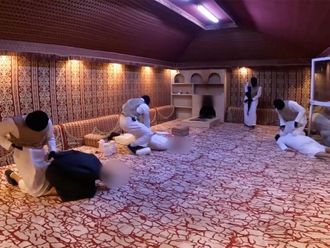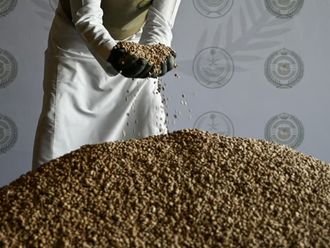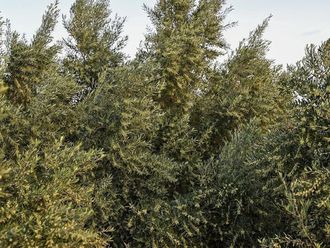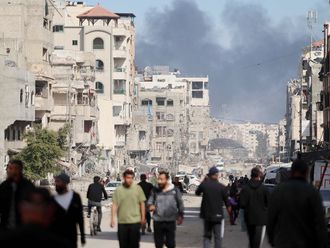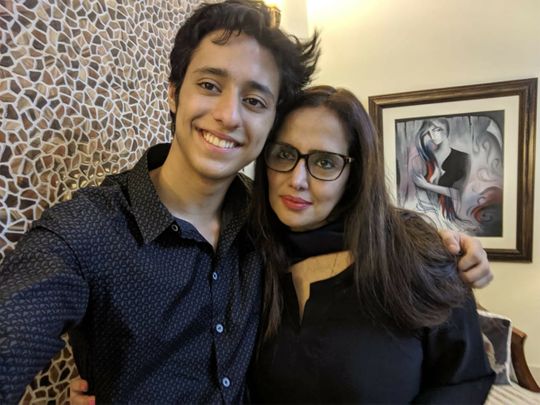
Highlights
- I felt calm when I was told my test was positive.
- I hoped I wouldn’t, but I always knew I would be – infected at some point.
- Everyone would be infected, whether they found out or not.
- That was the reality of the novel coronavirus that I silently accepted two and a half months ago when I started writing about it weekly.
I am COVID-19 positive.
I feel strangely calm.
June 5, I test positive for the disease that since March continues to be the single most important issue in the world of human beings circa 2020.
Having tested positive for COVID-19, on June 8, at 5:17am, Pakistan Standard Time, I am now one more statistic of the global 6,981,701, and 101,468 cases of Pakistan. In the last two days, the number of confirmed cases of COVID-19 has had a global increase of 222,491, and in Pakistan – take a deep breath before you read it – of 6,010.
These are huge numbers. We live in strange times. While Black Lives Matter protests, across all continents, voice the universal unacceptability of the systemic persecution and killings of countless George Floyds, the invincibility of the novel coronavirus remains unabated. Even where the number of deaths by COVID-19 appears to have taken a few-hour, much-needed rest, the number of the global overall cases still remains the biggest question mark on the apparent power of human beings.
As the knee of a white Minneapolis policeman takes the life of a black man who cries “I can’t breathe", there struts amok the global equaliser, the new respiratory virus, which chokes the breath out of humans without any discrimination of race, colour, ethnicity, creed, class, status, nationality, faith.
On second thoughts, in the United States, even COVID-19 disproportionately affects people of colour.
Two days after being COVID-19 positive, I still feel calm. It is primarily because I am not in pain. Right now. Allah is Kind. That is my primary strength.
The reason why I decided to tweet about my condition one day after I tested positive was simple: I did not wish to post anything that would cause anyone reading it more anxiety about their own health status, or increase their fear of getting a test, or make them rush to try a new medicine. As a responsible citizen of my country, and, primarily, as a conscientious human being, I feel it is my moral responsibility to disclose my status of having an infectious disease that spreads even in the presence of the strictest of measures, or even when you think you are practising all the WHO or government of Pakistan’s prevention guidelines. That is nothing less than a utopia. That the strictest of measures are truly the strictest in reality. That all prevention guidelines are followed to the tee.
Sharing with all of you how I got to this point is important. To me. If it makes even one of you see things differently, I’d be happy in my coronavirus-induced isolation.
I felt calm when I was told my test was positive. I hoped I wouldn’t, but I always knew I would be – infected at some point. Everyone would be infected, whether they found out or not. That was the reality of the novel coronavirus that I silently accepted two and a half months ago when I started writing about it weekly.
In February, when people in Pakistan were busy doing everything but paying attention to the virus that had embarked on its unobtrusive lethal journey of infecting and killing people across the globe, I tweeted about it.
The first time I read about the novel coronavirus was in January. I thought it was a China-specific disease.
My first tweet on the novel coronavirus was on February 1.
By that time, I was aware it wasn’t a “Chinese virus” with merely the potential of limited devastation.
How I contracted the virus
From February 1 to June 5, my story is uncomplicated.
Since September 2017, I have been in so much self-prescribed isolation that Pakistan’s March lockdown was neither a blow to my life nor trauma to my mind. Deeply concerned about the millions of Pakistanis whose lives were instantly and for the foreseeable future affected by the lockdown, I understood and respected Prime Minister Imran Khan’s decision of a complete lockdown. My life continued as ever. Mostly.
My son came home from college on March 18. I spent time with my family, I read, I watched crime shows on Netflix, and I stayed in touch with my few close friends via Whatsapp and voice calls.
One identical comment from almost all the people close to me after my positive result: “You never leave your room; how did you catch the infection?”
Whenever I did step out of the house, my constant refrain to the few people I interacted with was unchanging: wear a mask and maintain social distancing.
There was one regular activity in my life. That was my weekly visits to the graves of my mother and younger brother. The graveyard was always empty when I visited. The solitude of the last resting place of my beloved Ami and Babar was human-free. It was also infection-free.
Lockdown was lifted in Pakistan. Dark times lay ahead. Dread was pushed aside to make room for an ostrich philosophy. Pakistanis do escapism very well. Real life is mostly too bleak to handle. Just like the coronavirus.
I continued to write and tweet about the deadliness of the coronavirus.
In full endorsement of Governor of Punjab Mohammad Sarwar’s relentless warnings about the fear of an exponential increase in the coronavirus infections after the May easing, and later full lifting, of the lockdown, I even planned a reinforced coronavirus prevention campaign in collaboration with the Governor House. Now it will have to wait until I’m free of COVID-19.
The sheer irony of that…
Between May 9 and the first week of June, I went out of my house very few times – other than my weekly visits to the graveyard. The last time was on May 29. And that is when I think I got infected.
I was at a friend’s house. There were three of us sitting in a good-sized living room. My friend wore a mask – the protective one not a metaphorical mask. She didn’t take it off, and when I asked her why she was wearing it when it was just three people in the room, all seated metres away from one another, her answer, more or less this: She meets many people in her office every day, and she does not want to risk infecting people like me who don’t even socialise.
Being a vociferous advocate of the imperativeness of a mask, I didn’t think wearing a mask in a disinfected, sparsely populated room was advised. It isn’t, as far as I understand WHO’s mask-wearing guidelines. I wear a mask, but not when I’m with two or three people, sitting apart from one another. Also being a childhood asthmatic and having had seven nasal surgeries, I feel suffocated if I wear a mask for too long. My alternative to that is maintaining social distance or complete isolation. Both didn’t work.
As I think about leaving, three people arrive for a brief official talk with the hostess who works for the government of Punjab. The three gentlemen work for the government in various capacities, too. One of them is also a politician and a celebrity. He sits on the other end of the room from me.
No one sneezed, or coughed, or wheezed, or looked feverish. The room, despite air-conditioning, was not cold. Two doors were open. No one sat very close to anyone. There was no hand shaking.
Two days later, the politician-celeb announced he had COVID-19. I texted him my best wishes. I texted the other two to get tested. One of them had COVID-19, the other didn’t. I didn’t think much about any of it after I texted them.
Until I felt that there was something wrong with me. The first four days of June. I had body aches. For some inexplicable reason, I have not had fever in probably more than two decades. What I do have is body and head aches, and a feeling of being feverish. A few years ago, it was a frequent phenomenon. Now it is rare. I thought that it was exhaustion of fasting and eating very little. Perhaps I had not worked out in a month. Maybe it was sheer sleep deprivation. I had not slept for more than three hours in weeks.
My body pain and headache remained unresponsive to medicines.
I even tried Lexotanil for two days, just to sleep. I don’t take sedatives. Even when I feel extreme anxiety. I was tired of the pain.
One tweet of Dr Faheem Younus, MD –“Tweeting health, from the COVID frontlines. Chief of Infectious Diseases, University of Maryland Upper Chesapeake Health”– was the final push. I owe him a big thank-you. Dr Younus and I follow one another on Twitter, and he is my go-to expert for coronavirus and COVID-19 on twitter. The tweet that made me even think that there was something truly wrong with me was:
On the insistence of my niece and son, I got myself tested on June 4.
I slept that night.
The next afternoon, when I was trying to sleep again, my niece knocked on my door and told me my test was positive. I mumbled, “Okay.” I slept. I did not take any painkiller that day.
Since June 5, since being COVID-19-positive …
The same day, through a very kind friend, I spoke to a COVID-19 treatment doctor.
On June 6, at 11 am, I had my appointment with the doctor. A chest x-ray was done. Oxygen saturation, blood pressure, and other vitals were checked. Everything was normal. A huge relief for the 52-year-old, not-so-active me, with my chronic left temple pain, and a not-so-healthy lifestyle.
Isolation was mandated.
Also prescribed was a three-day course of one medicine, one tablet a day, the name of which I would keep to myself. Everyone suffering from the disease should only listen to their doctor and NO ONE else.
I bought the meds, got a new mask, and returned to my room.
I took the first tablet at 2pm. I went to sleep at 5pm. I woke up after 9pm. My pain had completely vanished.
On June 7, I took the tablet again at 2pm.
I’m still pain-free. I’m sleeping well.
My diet is what it has been for a while: fruit, fresh salad, milk, cereal, chicken, boiled starch-less rice, eggs, a piece of bran bread, and tea with milk and brown sugar. And lots of water. The only supplement I take is CAC 1000.
In a couple of days, I may incorporate some form of exercise in my daily routine. It could be just a few minutes of walking in my room and my tiny terrace.
Allah is always Kind. And He expects His people to be rational and do the things necessary for their wellbeing. I pray a lot. My faith is very, very strong. My faith simplifies my worldly actions, like starting treatment.
I stick to one doctor’s advice. I don’t pay attention to remedies and suggestions and totkas of online gurus and well-meaning but unhelpful family members and friends and acquaintances.
In a few days, I’ll be tested again. Until then, one day at a time …
That terrifying feeling
What is indescribable is the feeling of the awareness that my body is a carrier of infection right now. That I can’t touch anything without disinfecting it later. That I can’t hug my son. That I can’t sit on the same couch with my niece. That I can’t pet my dogs. It is scary as hell. It is humbling like nothing else. Invisible microbes have turned my hands into a medium of infection. No amount of handwashing makes my hands safe until I test negative for COVID-19. That terrifies me.
Temporary it is, but it is not easy. To not live normally. To not do what we take for granted. To not touch any human or animal. To not touch anything without disinfecting it later.
It is just for a few days – I hope, I pray. But until it is over, what I miss the most: not being able to hug my son.
But…
This too shall pass.
InshaAllah.





